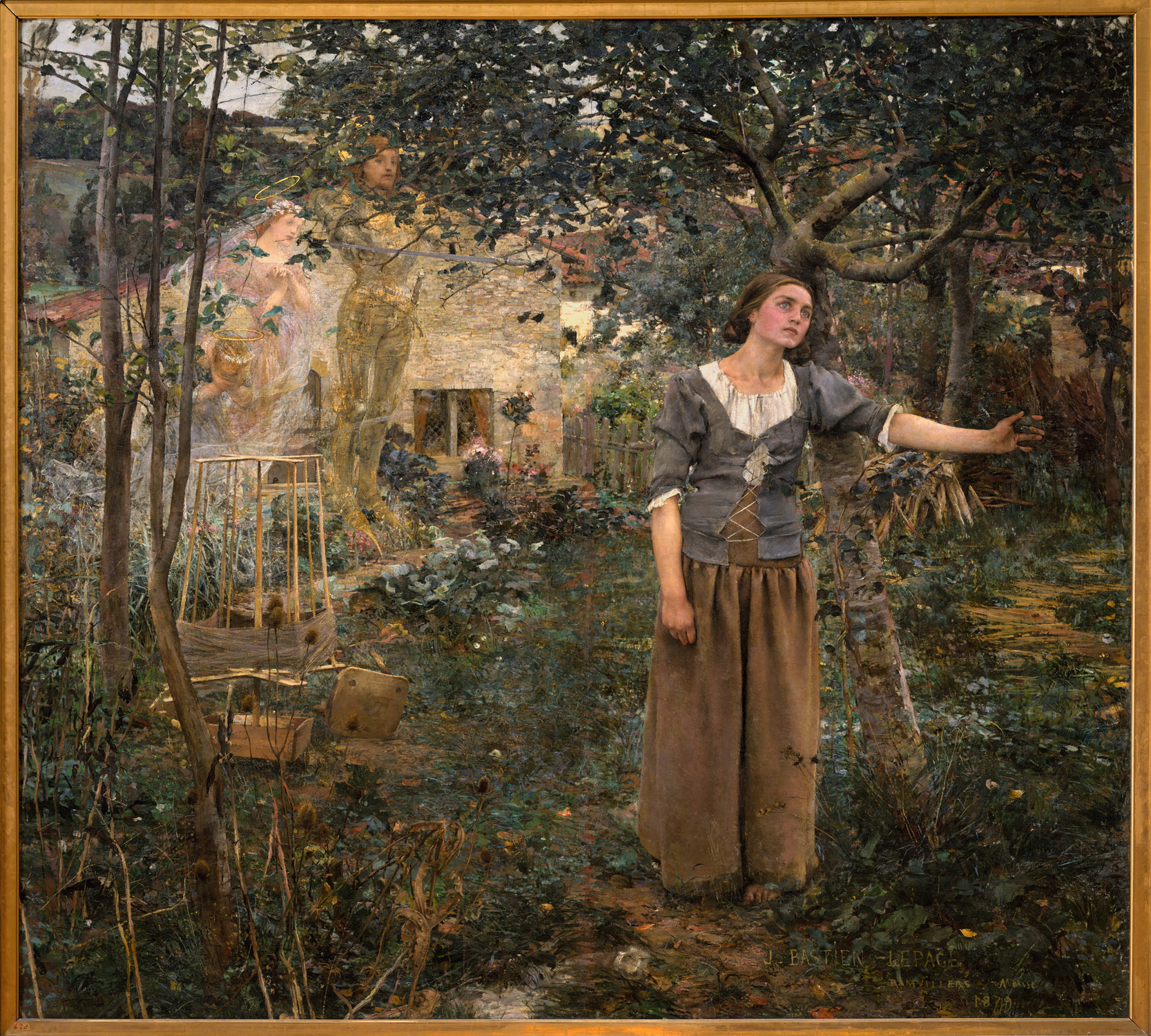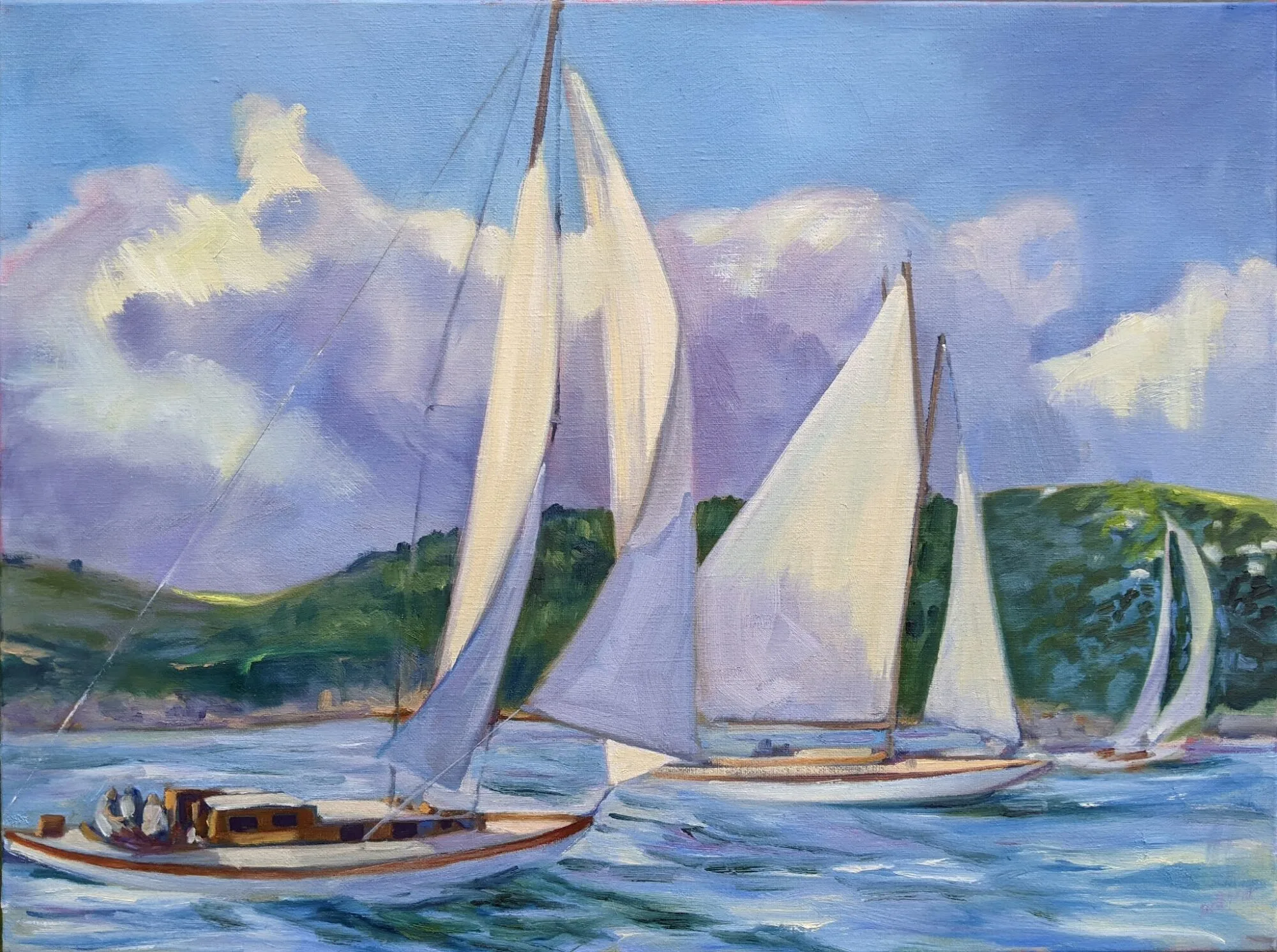John is a Baptist pastor from Alabama; I am an artist from New York. Can we find enough common ground in our Christian faith to make this work?

Joan of Arc, 1879, Jules Bastien-Lepage (French, 1848–1884)
Oil on canvas; 100 x 110 in. (254 x 279.4 cm)
The Metropolitan Museum of Art
Joan of Arc was born into a bleak moment in French history. France and England were entering the penultimate phase of the Hundred Years’ War. The English had captured huge swathes of territory and secured the French crown under the Treaty of Troyes, which also declared the Dauphin Charles VII illegitimate. The French countryside was bearing the brunt of a century of fighting, depredation, and the Black Death 75 years earlier.
At about age 13, Joan began to hear voices. Eventually, she sorted these voices to be those of St. Catherine of Alexandria, St. Margaret of Antioch, and the archangel Michael. These coalesced into visions. At her trial, she said: “I saw them with these very eyes, as well as I see you.”
By the time she was 16, her heavenly counselors had become more insistent and specific. She never recounted her visions at her trial, but there is a record of them that slightly predates the relief of Orléans. A Flemish diplomat named De Rotslaer recorded “that she would save Orléans and would compel the English to raise the siege, that she herself in a battle before Orléans would be wounded by a shaft but would not die of it, and that the King, in the course of the coming summer, would be crowned at Reims, together with other things which the King keeps secret.”
The story of her initial rejection (“Take her home to her father and give her a good whipping”) and eventual triumph is worth studying. Two details touch me. The first is that the Dauphin subjected her to a careful theological examination before entrusting his troops to her. The second is that her career ended abruptly after her visions were fulfilled.
Jules Bastien-Lepage was part of a movement in European art and literature known as naturalism. This embraced realism but often was invested with an awareness of the condition of the poor, which in some cases makes the art into manifesto (see Charles Dickens as an example). At the same time, the nineteenth century saw an enormous population shift from the countryside to the cities, so there are elegiac overtones in the genre.

Jean-François Millet (1814-1875)
Gleaners, also called, The Gleaners
Oil on canvas
Musée d’Orsay
(for a far better, copy-protected reproduction, see here)
Bastien-Lepage was temperamentally the heir of Jean-François Millet, who painted the incomparable Gleaners. About Millet, the Catholic Encyclopedia of 1913 said, “he has shown us how the trivial can be made to serve in the expression of the sublime, and how the Infinite and the Divine can be discerned in the humblest existence.” Vincent Van Gogh, Honoré Daumier, and Bastien-Lepage also had that sympathy, although it was tuned differently in each of them.
Bastien-Lepage painted Joan of Arc after the Franco-Prussian War. With their empire ruined and Alsace-Lorraine taken, the French identified powerfully with Joan. Bastien-Lepage’s painting is thus nationalistic, but to regard it as mere propaganda would trivialize it.
For one thing, there is the question of identification. Both the artist and the subject were from Lorraine. Joan was a peasant heroine and Bastien-Lepage was a peasant painter. She must have been an irresistible subject.

William-Adolphe Bouguereau
Tricoteuse, 1879
Owned privately
To understand the academic virtues of his painting, compare Joan of Arc to William-Adolphe Bouguereau’s Tricoteuse, painted the same year (Bouguereau vies with Caravaggio as the best painter of feet ever). The figures share the same perfection of drawing and modeling. But there the resemblance ends. In his best work, Bastien-Lepage used perfection only where it advanced his narrative, and there he pushed it to a photographic clarity—Joan’s loosely-laced jacket, the muddy shoes on the reaper. Bouguereau distilled detail to an ideal. His girl is an archetype of poverty, frozen in time.
In Joan of Arc, Bastien-Lepage introduced Catholic symbolism archaically, so we can almost read this painting like an icon. Joan’s own discarded spinning wheel (covered with wool so coarse we can practically smell it) stands in for St. Catherine’s wheel. Michael’s sword (Joshua 5:13–15) hovers in the air as a portent of the sword Joan would later find behind the altar in the chapel of Saint Catherine de Fierbois.
You can easily see Bastien-Lepage’s Impressionistic brushwork in the background of Hay Making, but it is also the device that allows the three saints to shimmer in Joan of Arc (we just can’t see it online). Moreover, he shoves us into the picture with Impressionist abruptness. We sense we’ve stumbled across Joan in her back garden. Compare this to Gleaners, which is profoundly powerful, but far more classical in its structure.
Nevertheless, Bastien-Lepage was not remotely an Impressionist. It is always Joan’s face to which I first respond. Her moment is awful in the deepest sense of the word. It is not that she has shut us out; instead, she seems to have stopped completely. Today many people see that frozen look as a failure, the result of painting from a reference photo. I disagree. It is a face of transfixion, of awed intelligence. After all, the face of the tedder in Hay Making, is hardly photographic, even though the painter was using the same technique. She is loose-jawed, beyond exhaustion.
This is where Bastien-Lepage diverges from the earlier naturalist painters. Millet saw nobility in the peasants’ suffering; Bastien-Lepage looked forward to the bleakness of the coming century. In the eyes of Joan and the tedder in Hay Makers, there are glimpses of the deep psychological pain of the German Expressionist Käthe Kollwitz.
Bastien-Lepage died young (at 36) and much of his work is either schmaltz or unformed. But some of it veers into greatness. I have to wonder what he would have produced had he lived longer.
(You can peruse Bastien-Lepage’s œuvre online here. You can read the transcript of Joan’s heresy trial here, and the nullification trial here.) In researching this, I also came across the delightful and idiosyncratic Hay in Art.)

Thanks for sharing this, Carol. This Tricoteuse painting is really beautiful – what an intriguiging portrait this is! The ‘Les foins’ painting is not visible on my screen – only if I click on the link that you provided.
Carol,
WOW! After I get my dictionary out and decode this incredible post I will be processing my thoughts for a post on this marvelous painting. If I’m ever in NYC you will have to promise to personally introduce me to this marvelous piece of work!
Thanks for stretching me. Hope I can do justice to this. Definitely in over my head…
John
Let’s see if the problem is there for other viewers; it looks fine in my browser.
I fixed the link to Joan of Arc so you can see an enlargement when you click on the picture.
I think I know this painting in the flesh. I remember once being in the MMA with a friend and turning around, from one painting, to move to the other side of the room, and stopping in my tracks. I said to my friend, “That is how I imagine Joan of Arc would look.” And then I read the title.
I can’t be sure because even the enlarged version does not let me get close enough to the eyes, which I thought were fixed on God or some very firm and high purpose.
In the terms that Jean Shinoda Bolen introduced in ,Goddesses in Every Woman,, the eyes of Joan of Arc, in the painting I remember, were the eyes of Athena. Glaucous-eyed Athena, often accompanied by an owl. (See references to Athena at http://www.goddessgift.com/goddess-myths/greek_goddess_athena.htm)
So, it just seemed right to me that someone who looked like Athena should be Joan of Arc.
I, too, cannot see Les foins, although I’ve tried a couple of ways to get it to reveal itself to me. I found it by using Google…
I love the eyes of Joan of Arc, the face of the knitter, and the face of the woman reaper. Interesting how they each fascinate me.
BTW I was looking at a watercolor painting tonight i the mall and suddenly realized that I regard watercolor:reality::novels:films.
I like to be free to dream, not to be compelled by too much detail!
But what Bible reference do you find in this painting, beyond the religiousity of its subject?
Of course, Gwendolyn, you’ve called me out. There is no direct Bible reference. I started thinking about this on All Saints’ Day. Of course it’s a nettlesome subject for John, so I hope all dozen of my readers are supportive of him.
The goddess you mention was often called Athena Glaukopis, which is a combination of glaukos (gleaming, silvery, bluish-green, gray) and ops (eye). The word has the same root as glaux, which means “owl”, which was Athena’s totem. I think your reference is apt because the owl and the glaucous eyes both imply a different sphere of seeing. In English, we have extended that word to the disease glaucoma, which unfortunately twists its meaning.
I remember Joan’s eyes in the painting as gray, but who knows? I haven’t seen it in life for at least a year. John, I will of course take you to see it, but know that the Metropolitan is only one of many great art museums in New York, so plan accordingly and wear good walking shoes.
I know the painting by Jean-François Millet. I took modern art history, and we had a brief encounter with the painting. I also remember later proceeding to look at ?russian art…?
I think there was a movement during the time period or something…
Hi Carol,
I was so pleased to receive your comment on my blog – thank you for the kind encouragement! I’m also glad to have found your wonderful site here. It will be a pleasure to stop back in the future and learn more from you.
The paintings you shared lovely, I especially like the one of Joan of Arc.
Miriam,
I’ve added your blog (“Living Fragrance”) to my links and encourage others to visit it. Thanks to John for directing me to it.
Carol
Carol, the link is an honor. 🙂 I was wondering how you came across my little place. I have a dear cousin in Rochester who is a blogger, so I thought maybe it was her who pointed you in my direction. Now I’m curious about how John found me. 🙂 I find connections in the blogosphere so interesing.
I meant to mention before that I think your collaboration with John sounds like a really neat idea. I look forward to seeing how it goes.
Where is your dear cousin? This is not that large a city; perhaps I know her.
We’re looking forward to seeing how this collaboration goes, too! A friend told me it was “off-task” which is certainly true since the original purpose of this site was to discuss painting technique. But who cares? If artists can’t be off task, who can?
Carol,
15 days later and I am finally close to publishing my response! sorry for the long delay and I must ask forgiveness for pressing you so hard for your first post. Little did I realize what I was getting into! Look for my post on Wednesday. Perhaps by then I will have my typos cleaned up and my thoughts sharpened to a less than razor sharp edge. :-).
Thanks for the challenge!
Would you please be my guide in finding the third voice in Lepage's Jean d'Arc. It is illusive. I found St. Michael and St. Catherine, but not St. Margaret.
Many thanks.